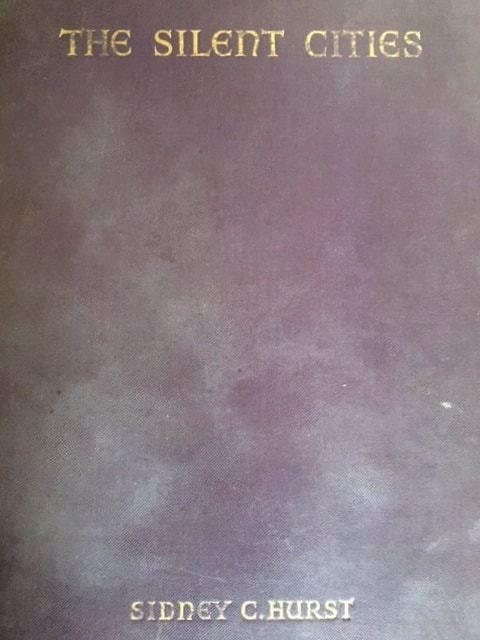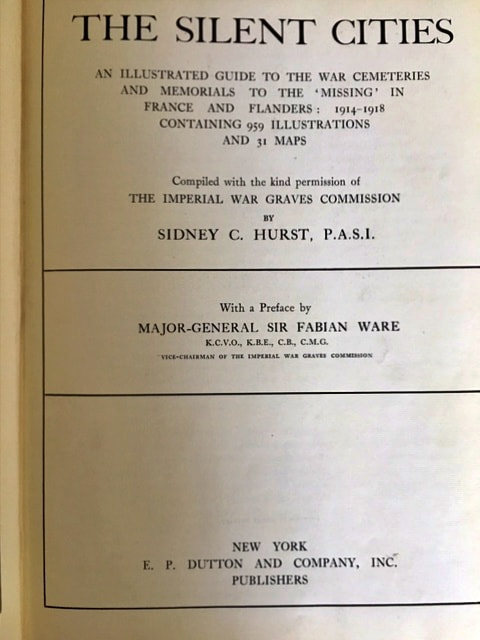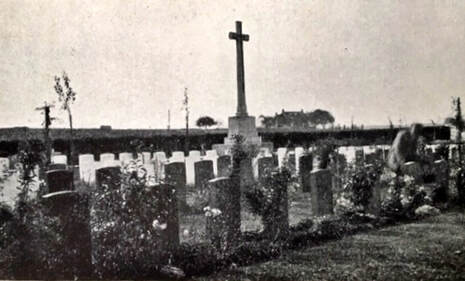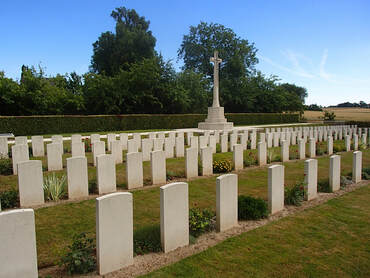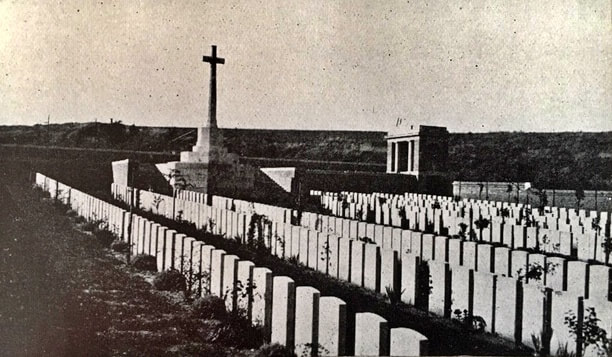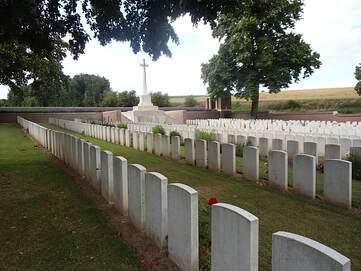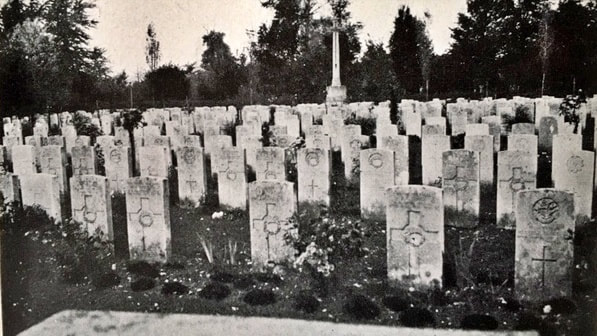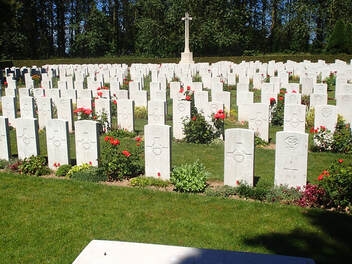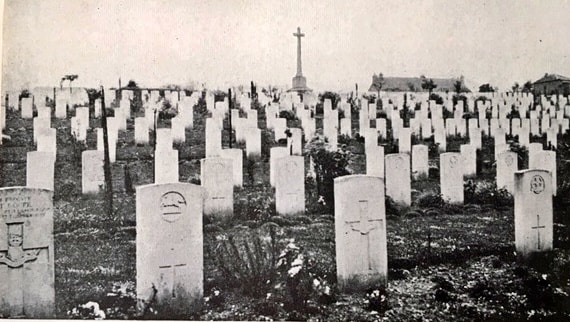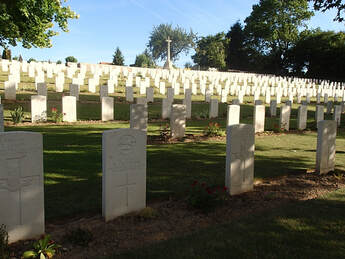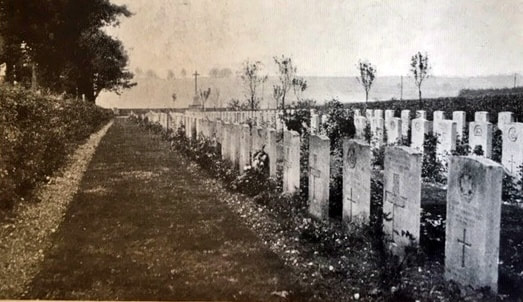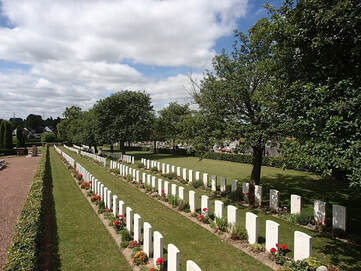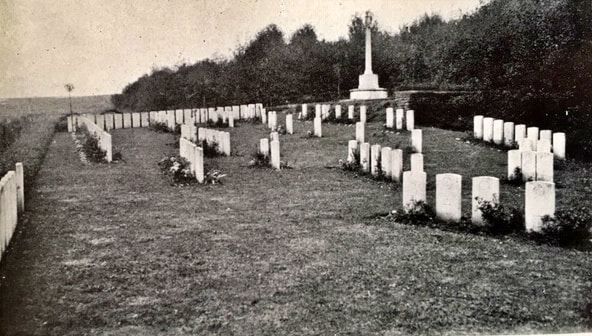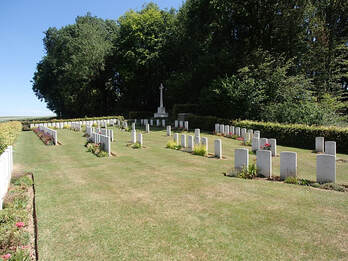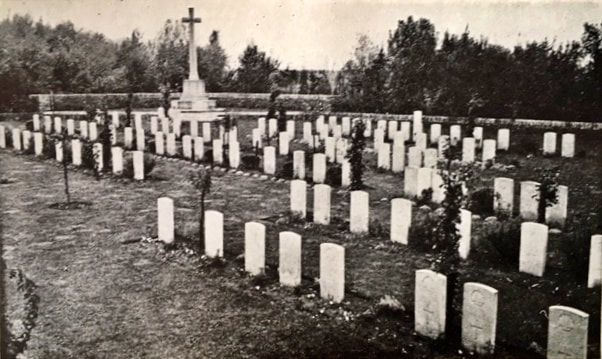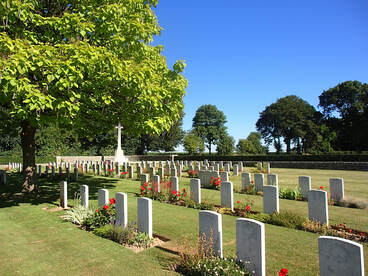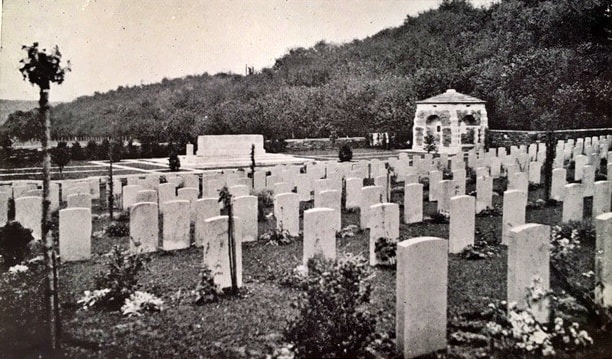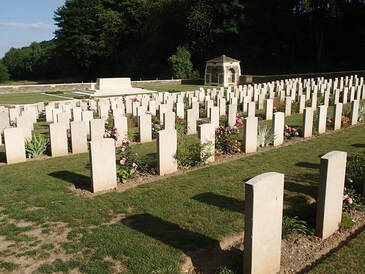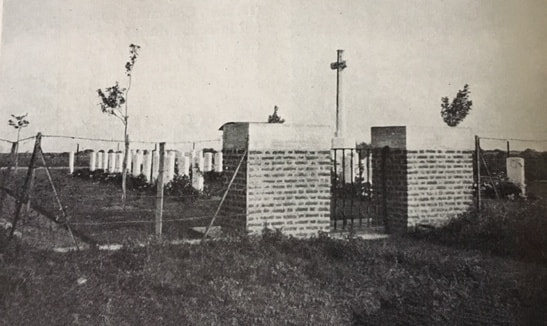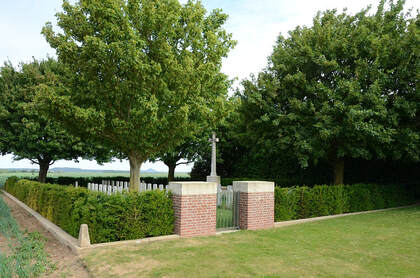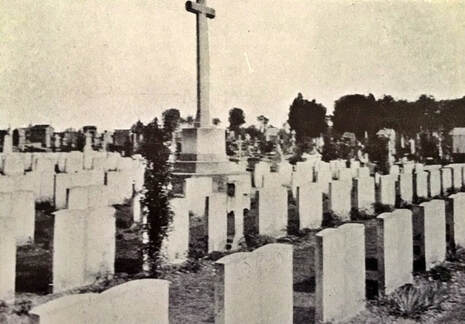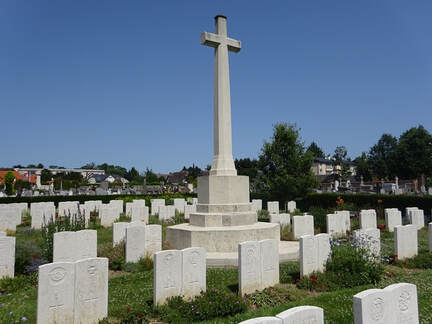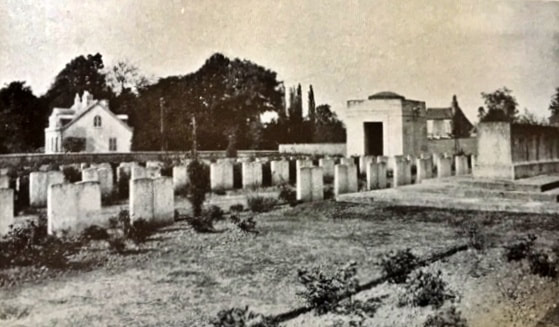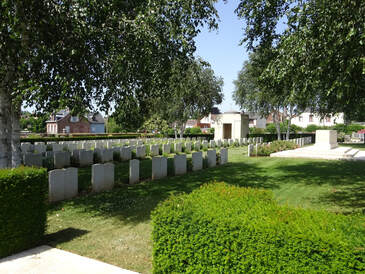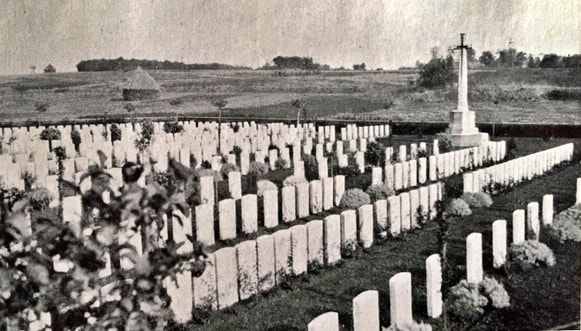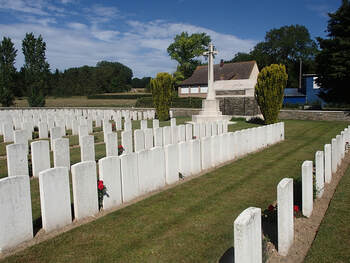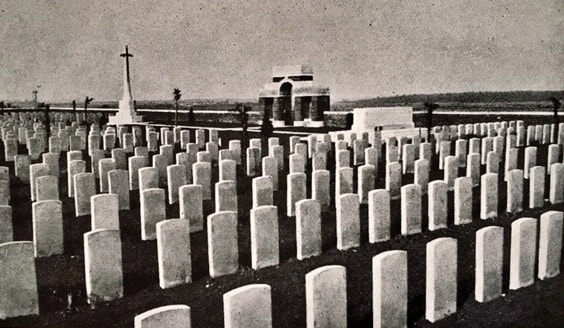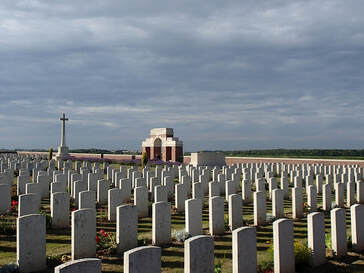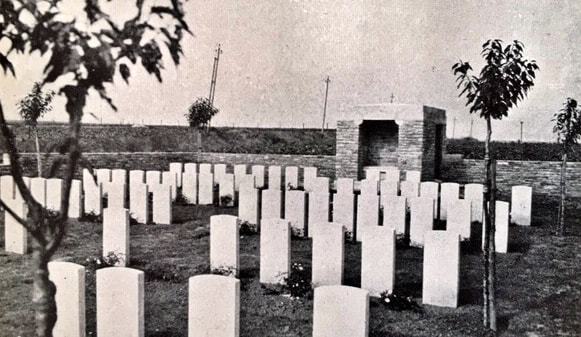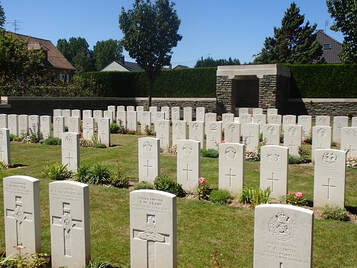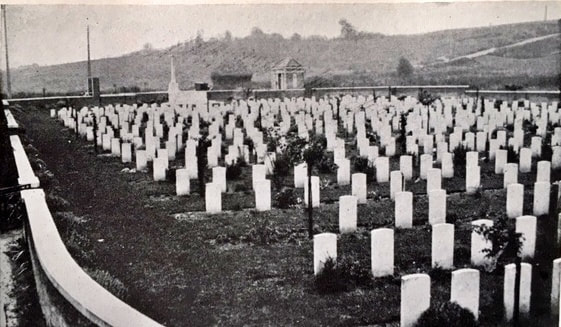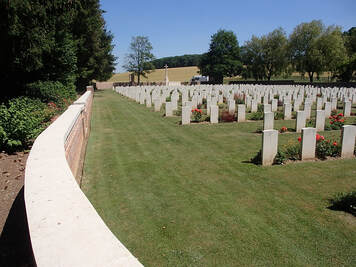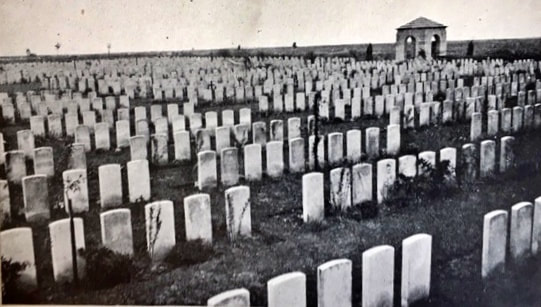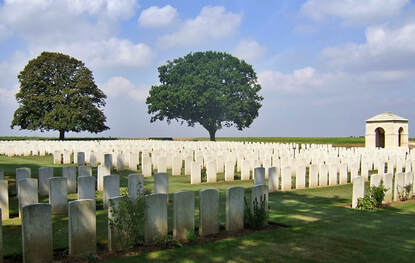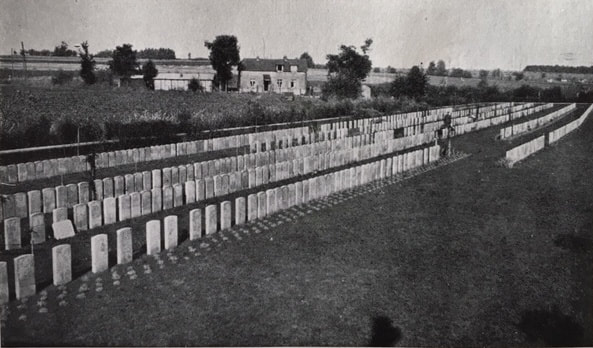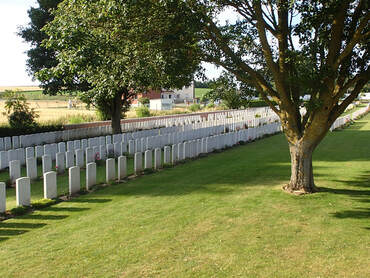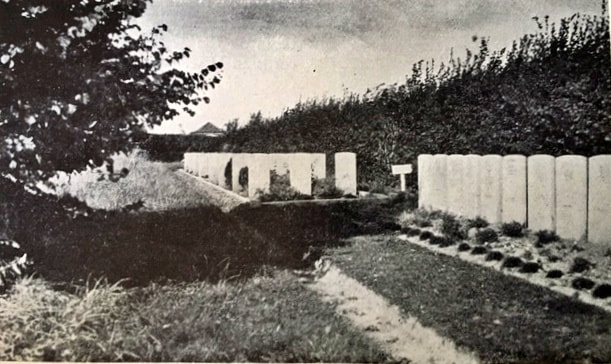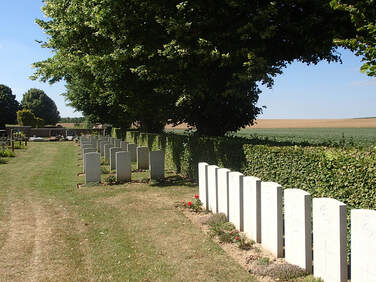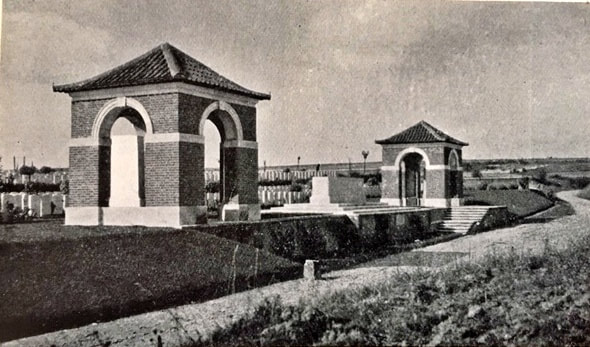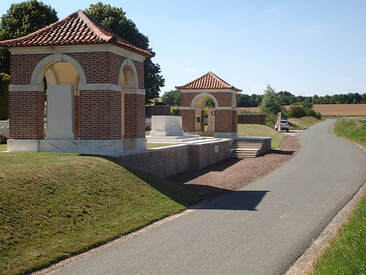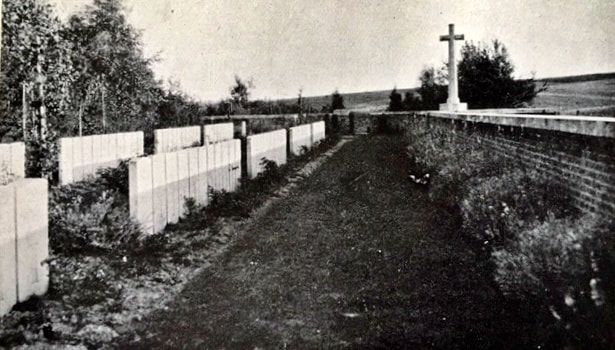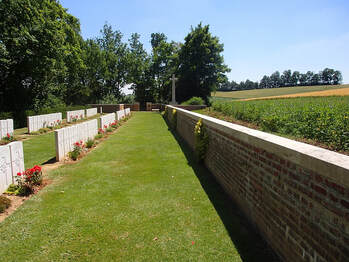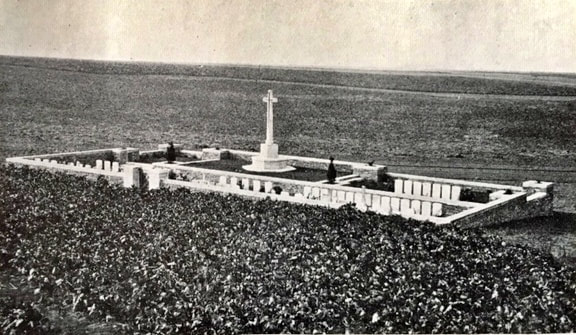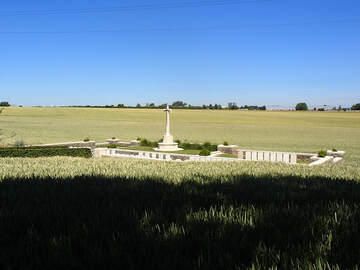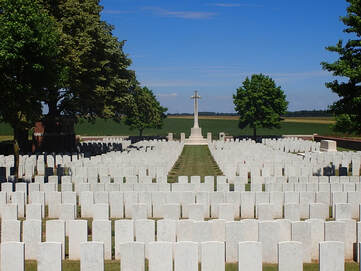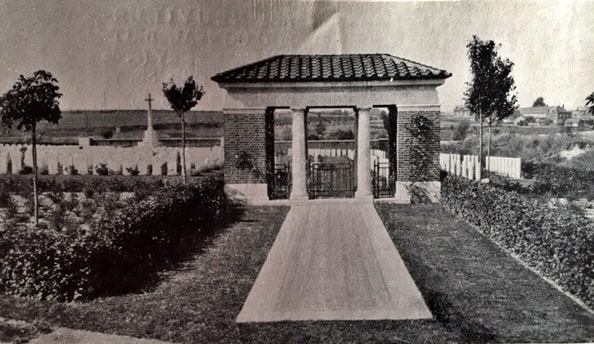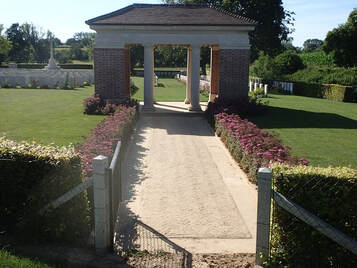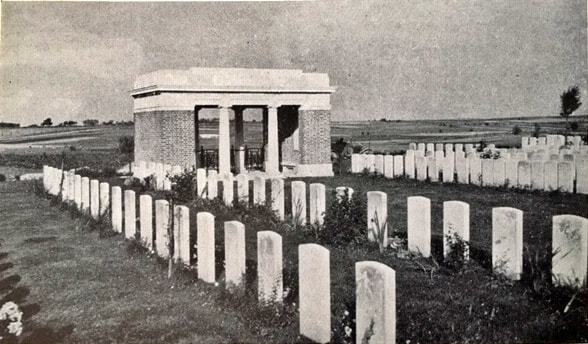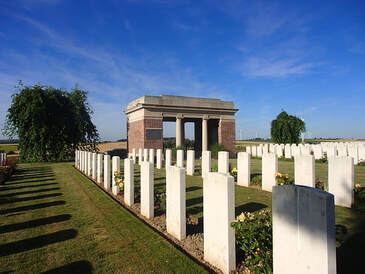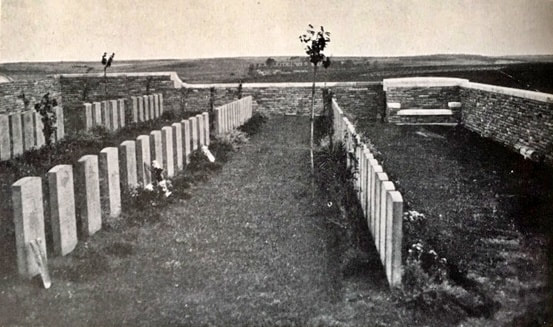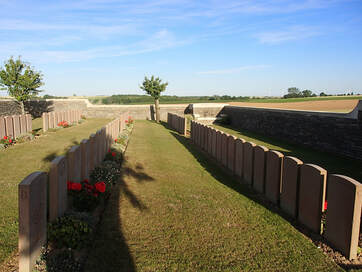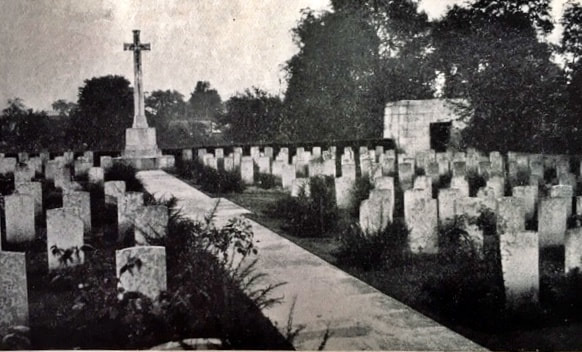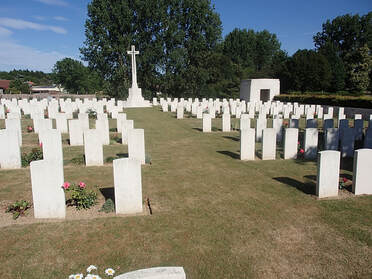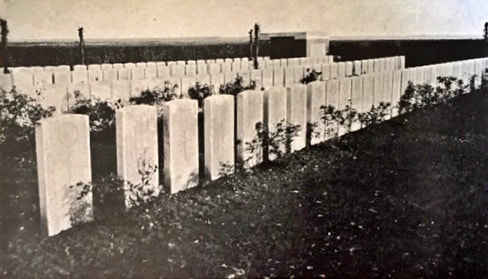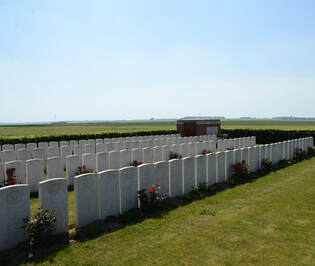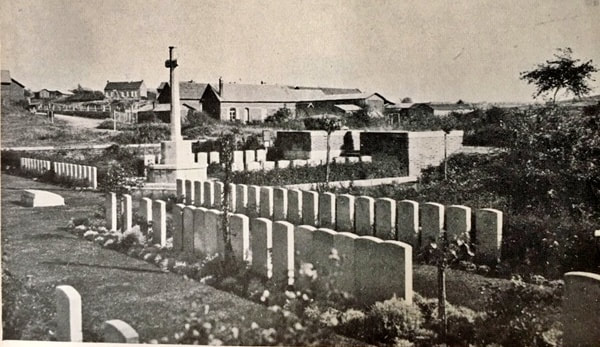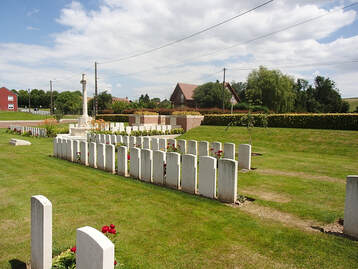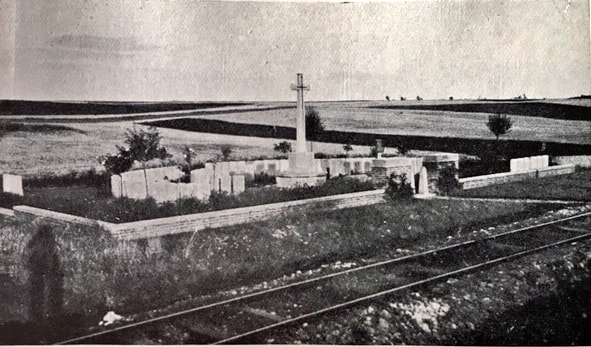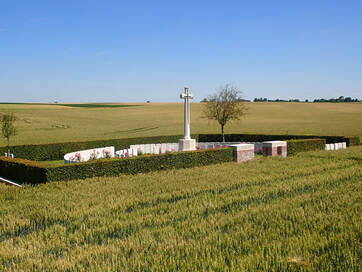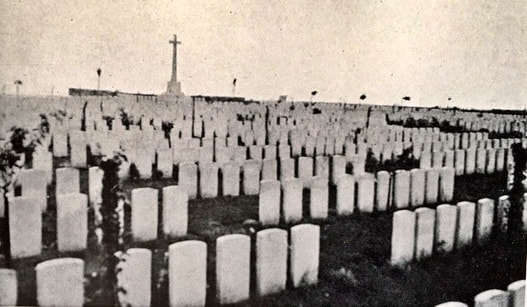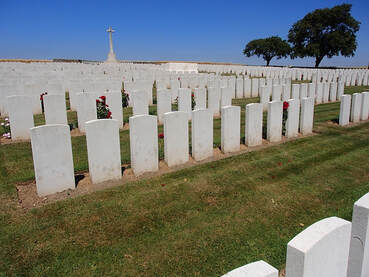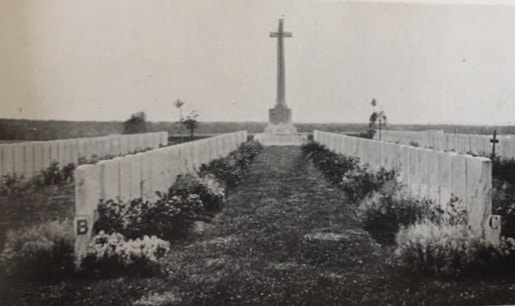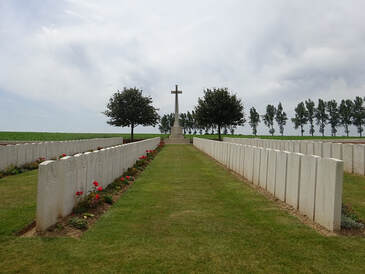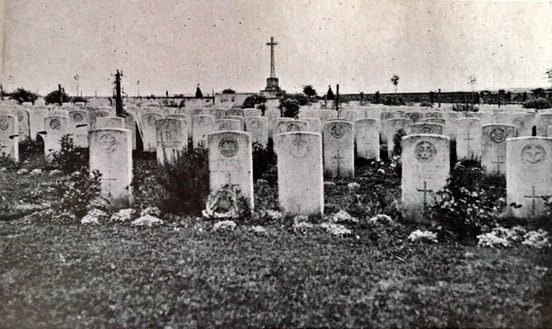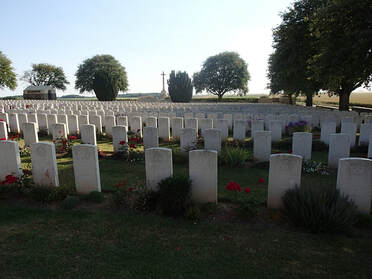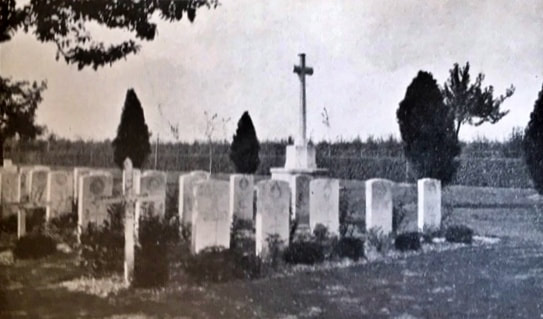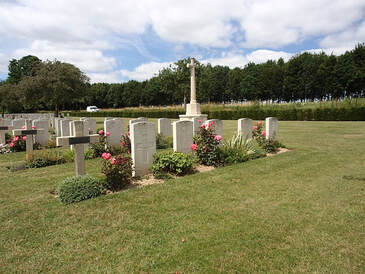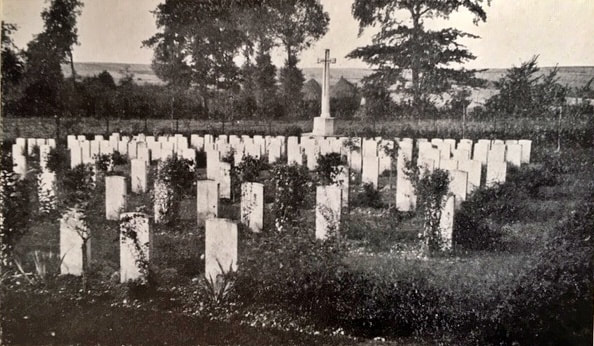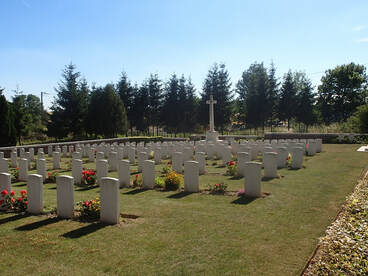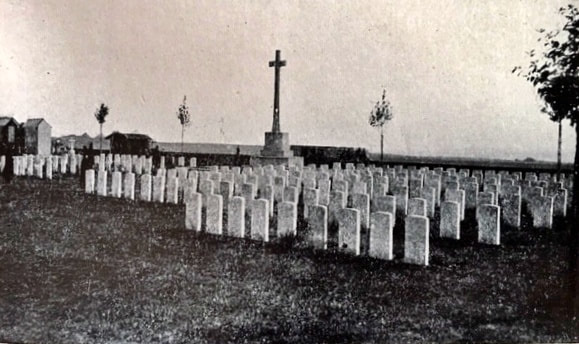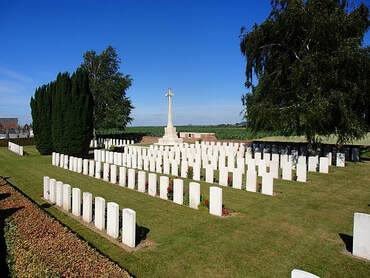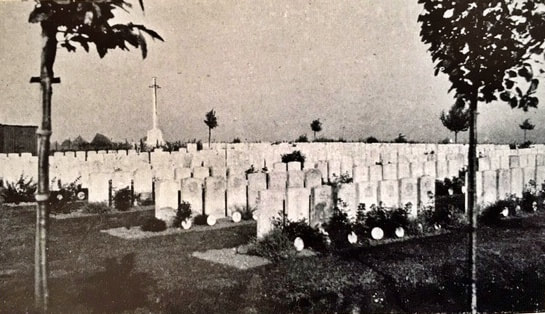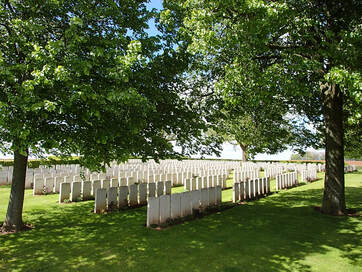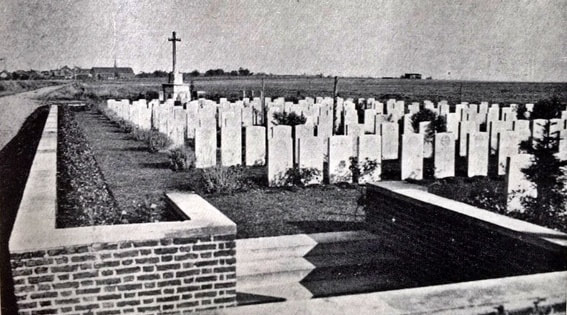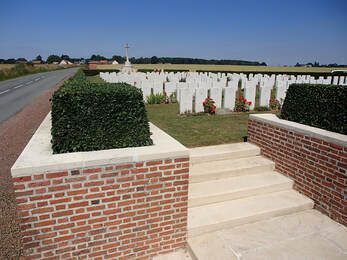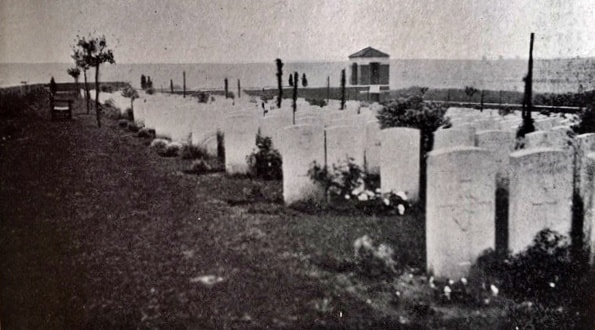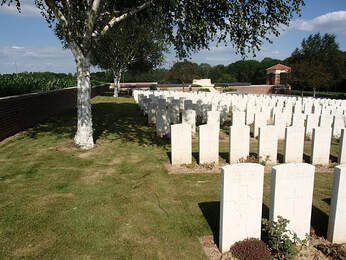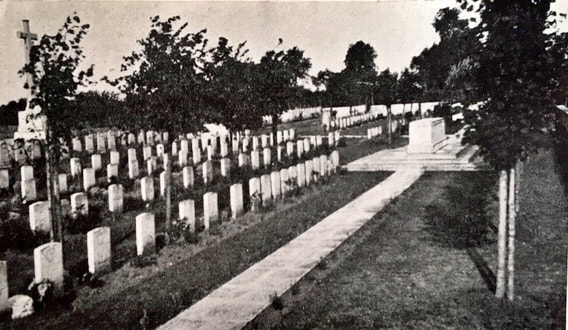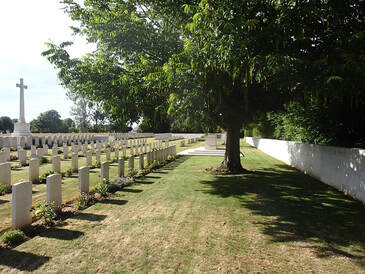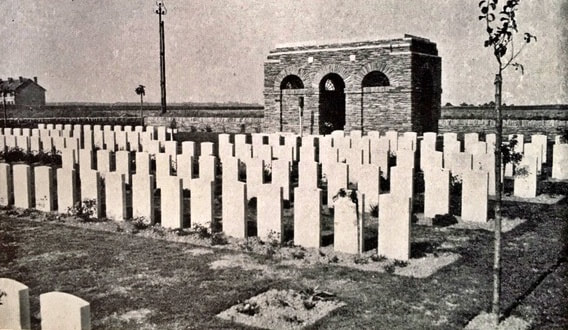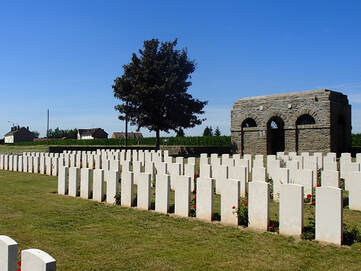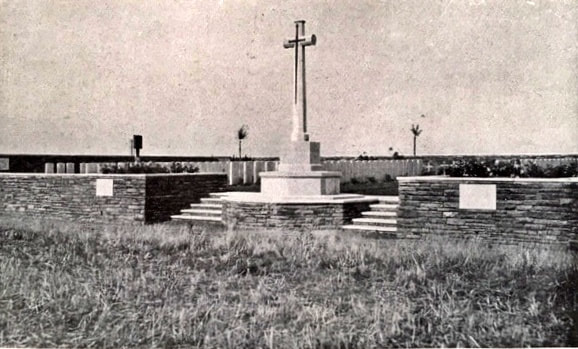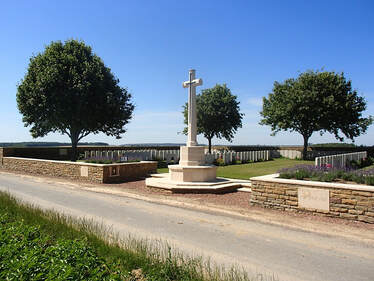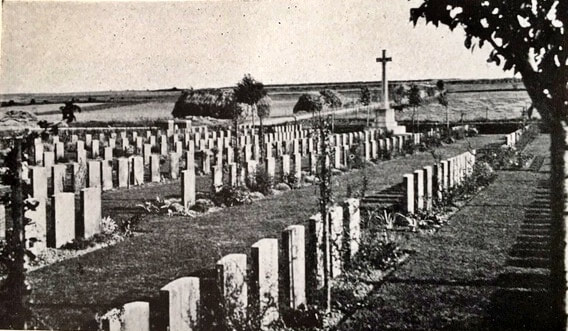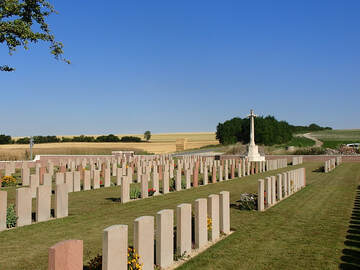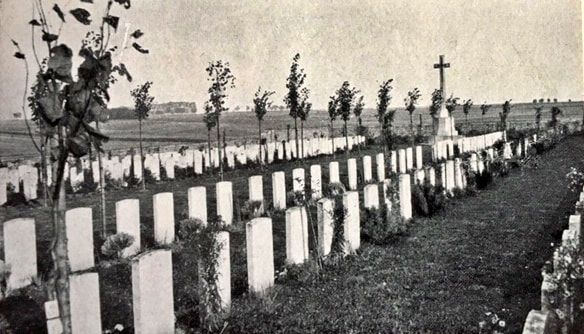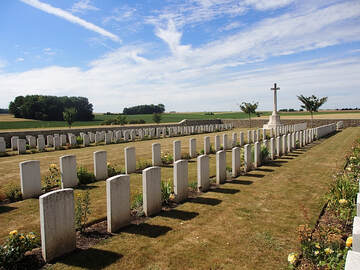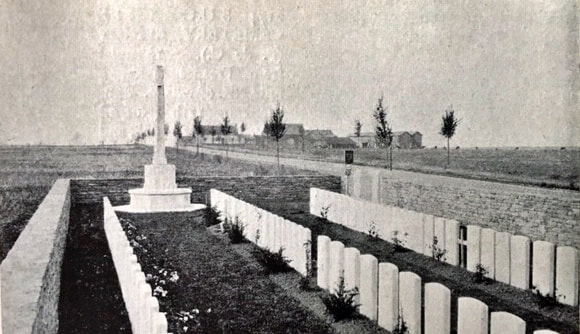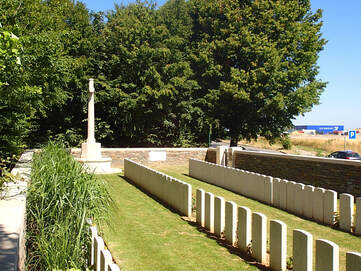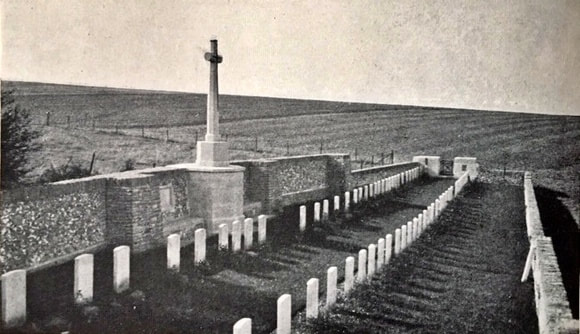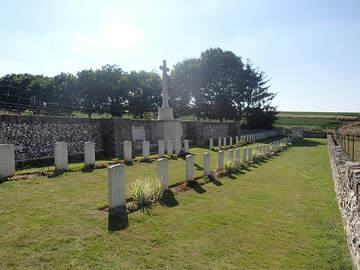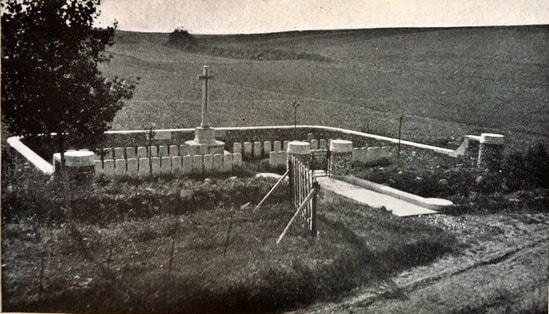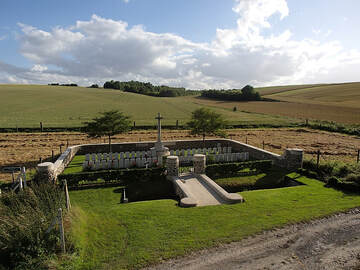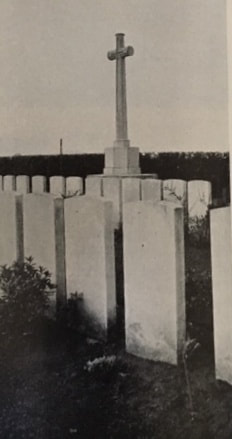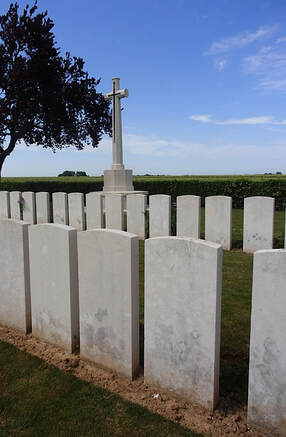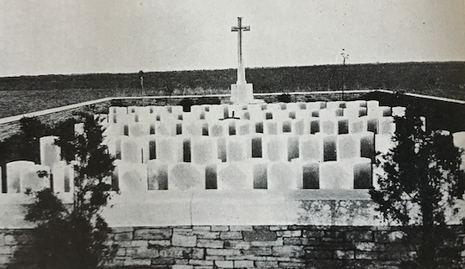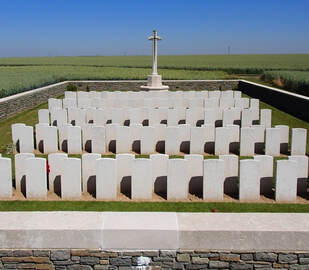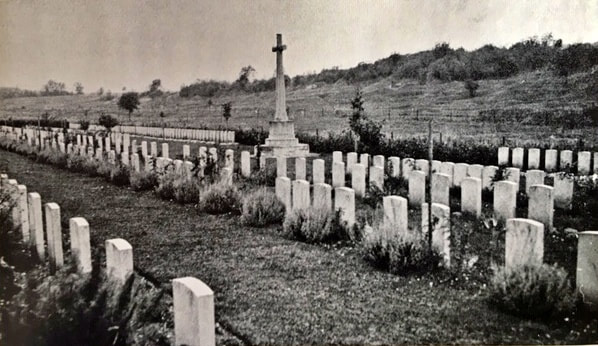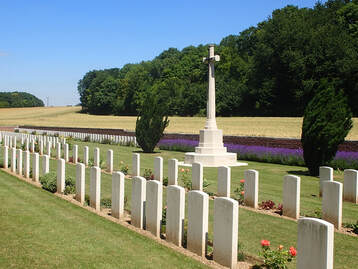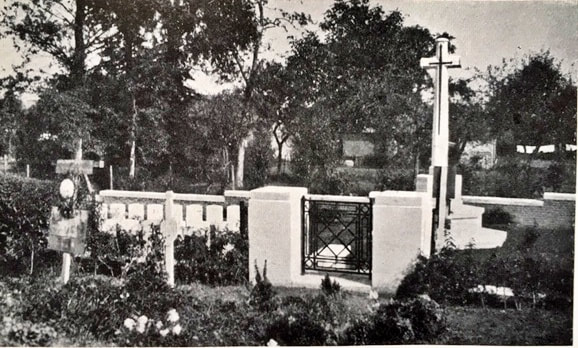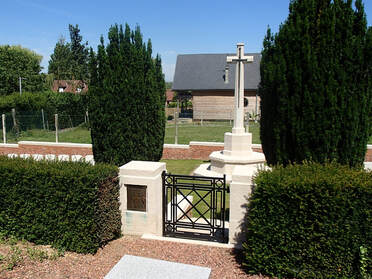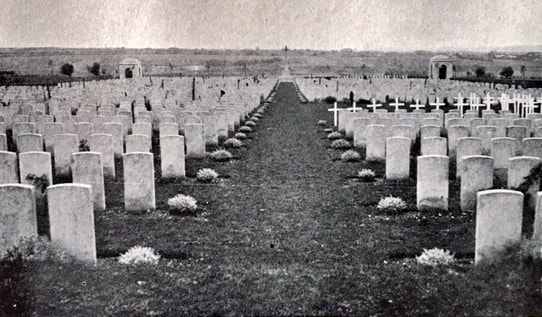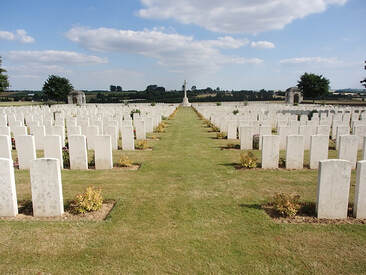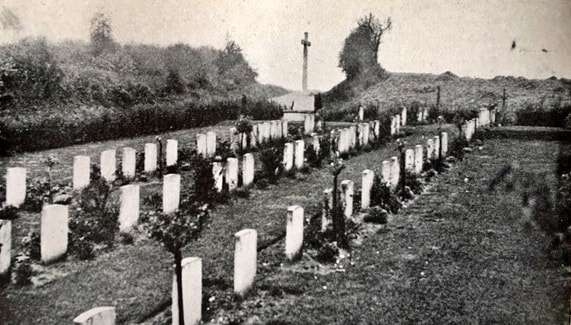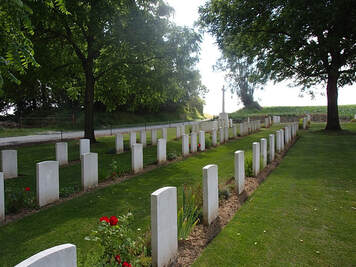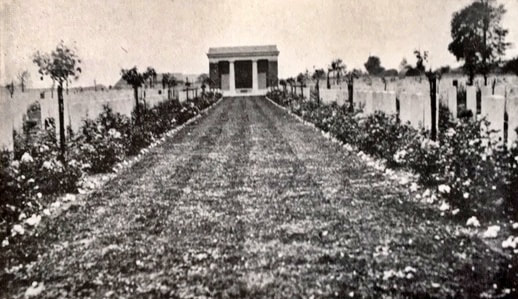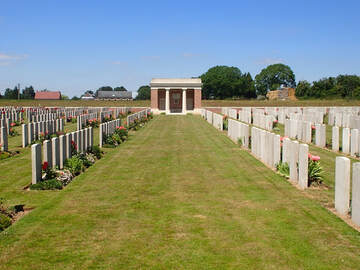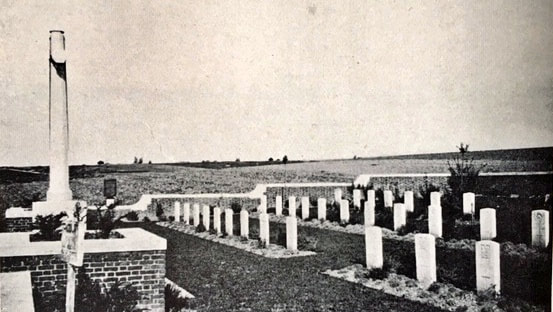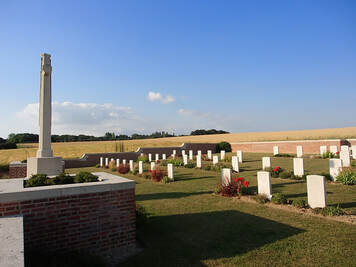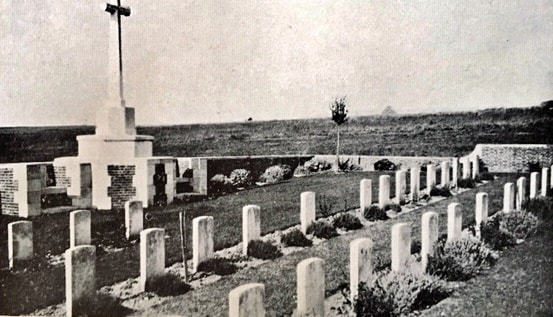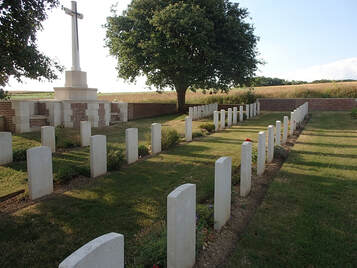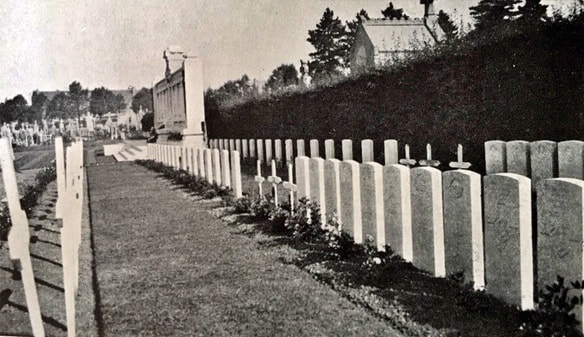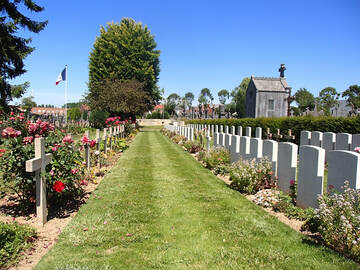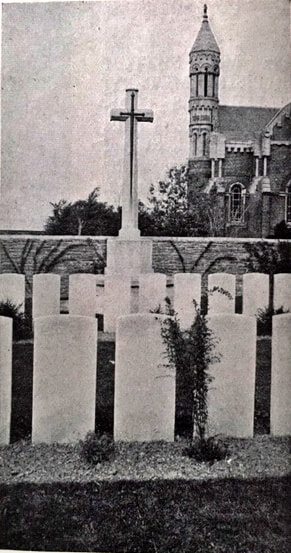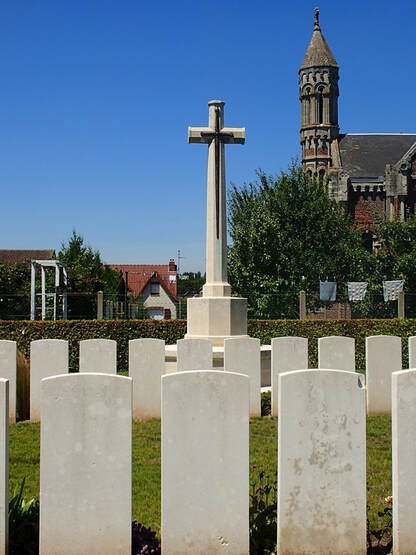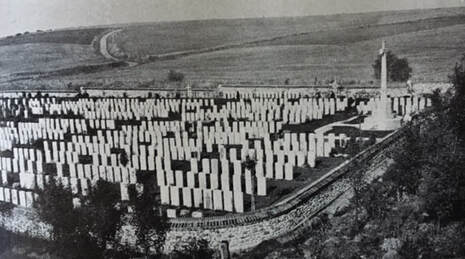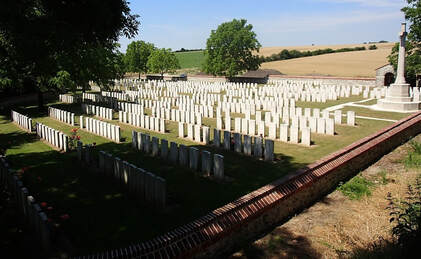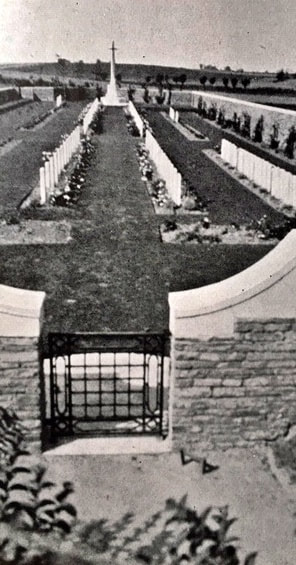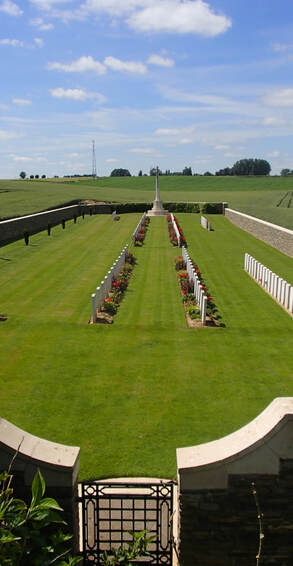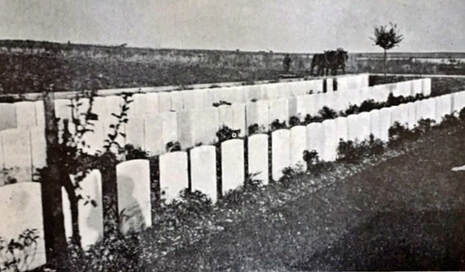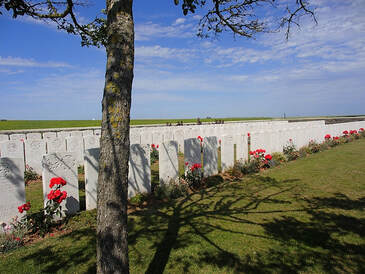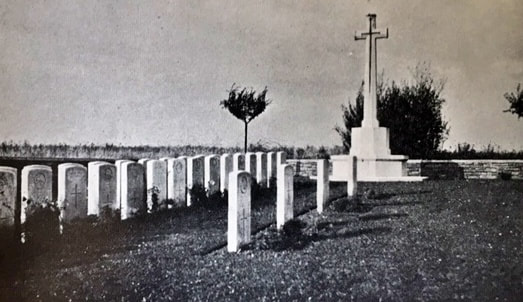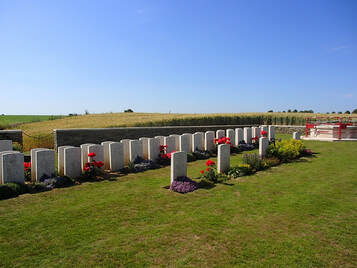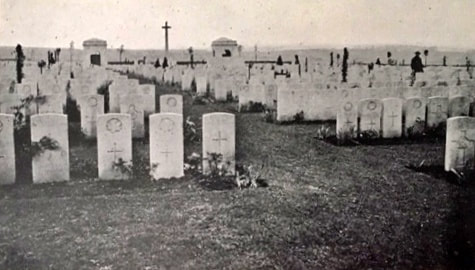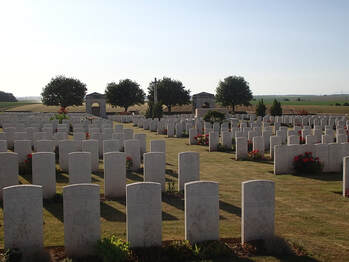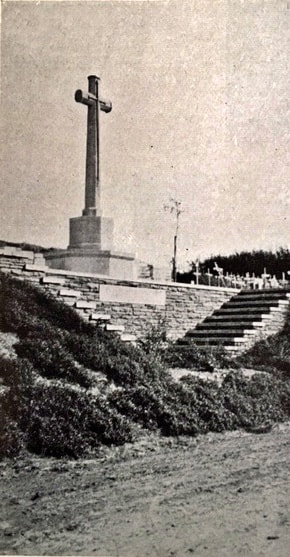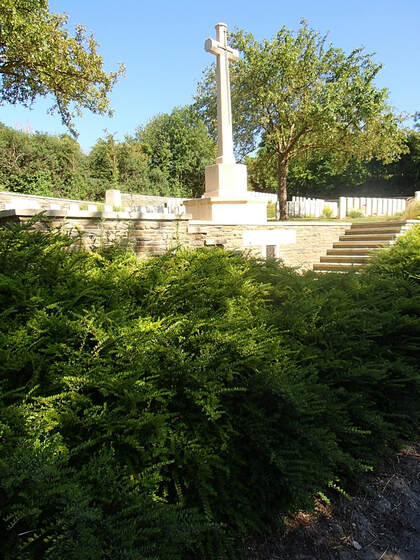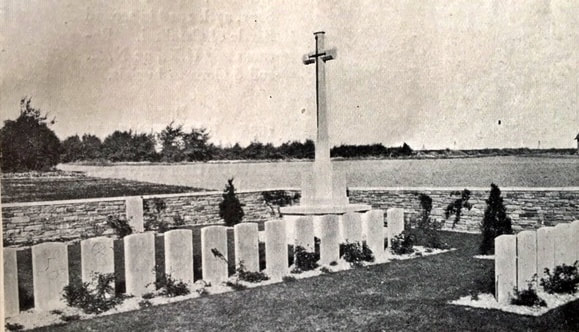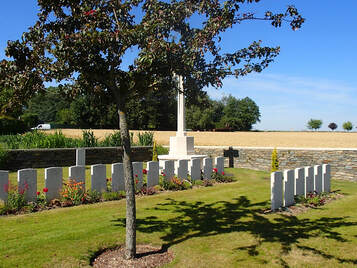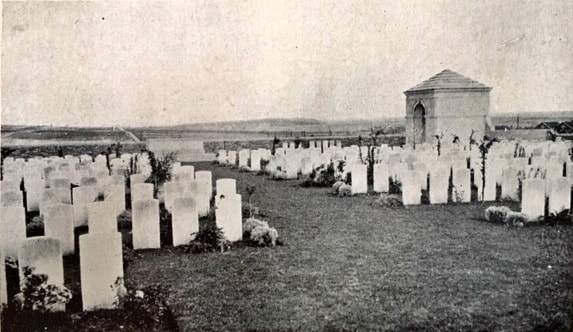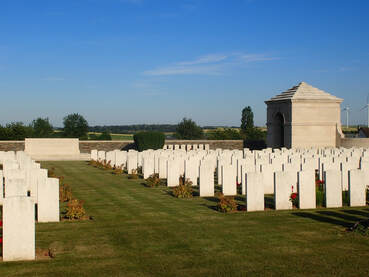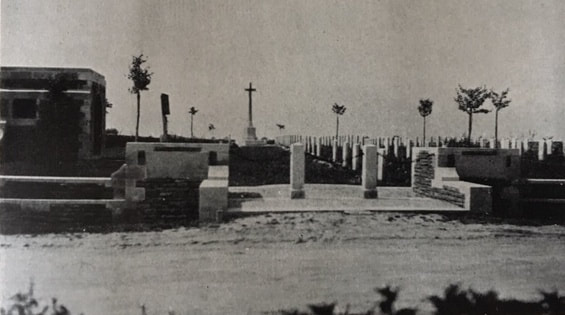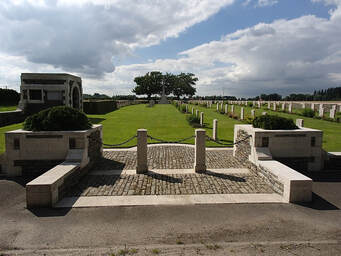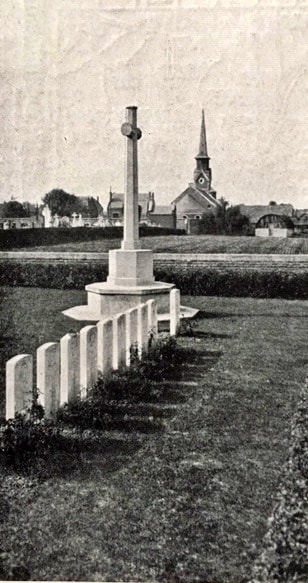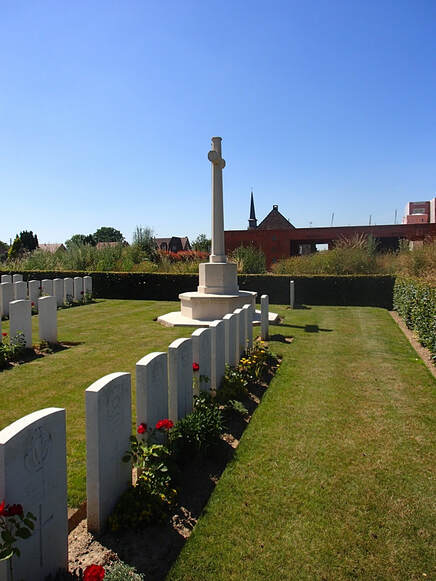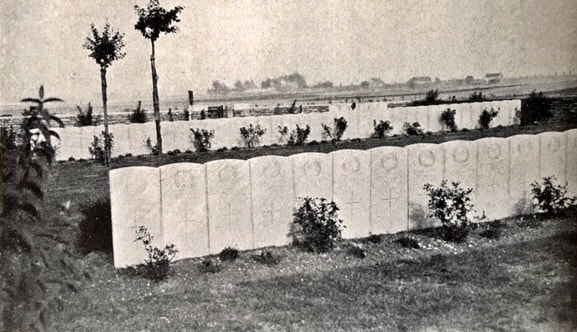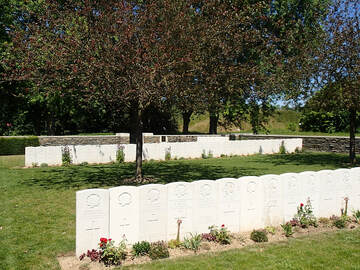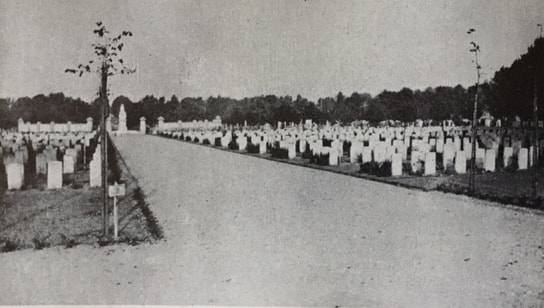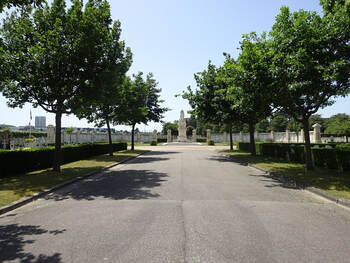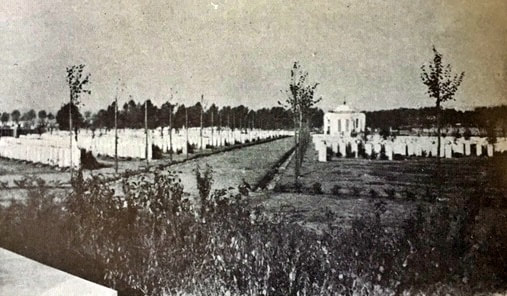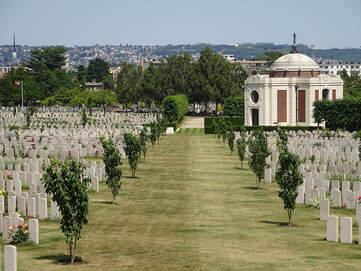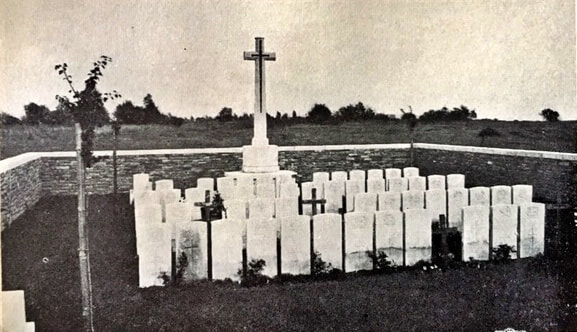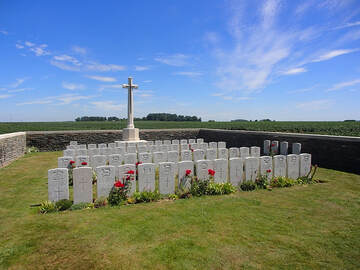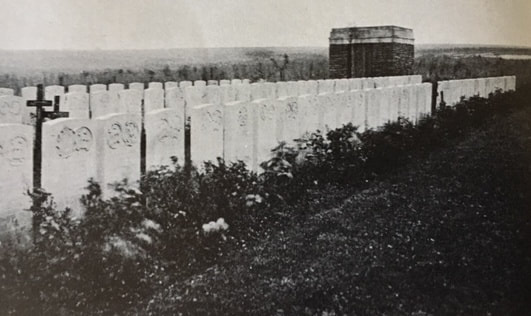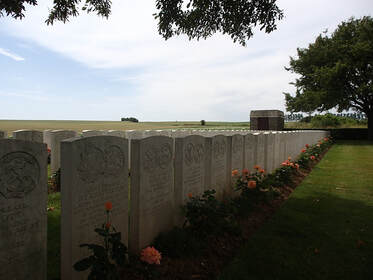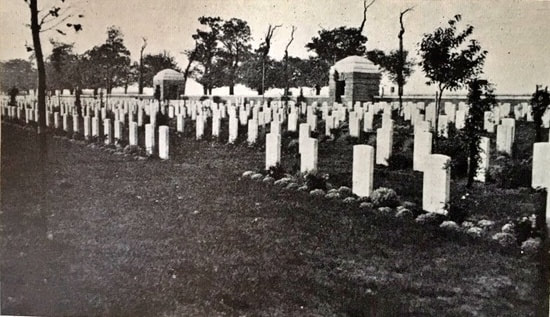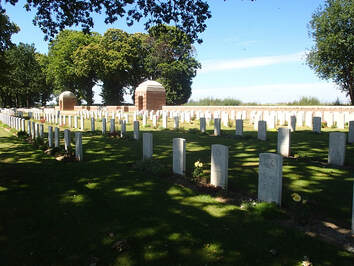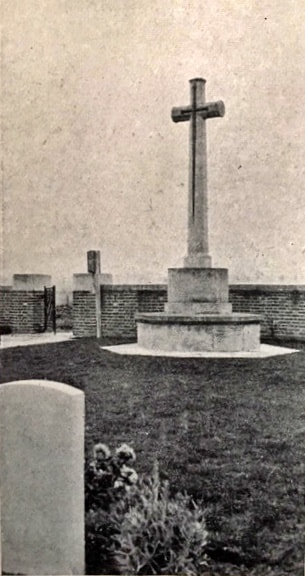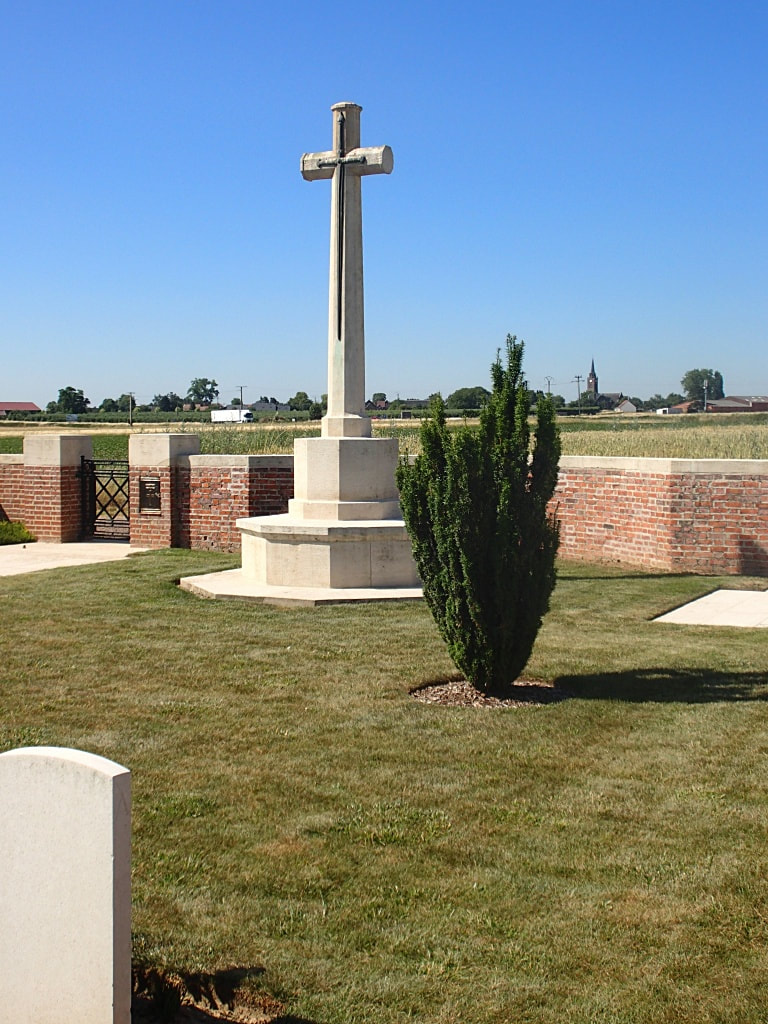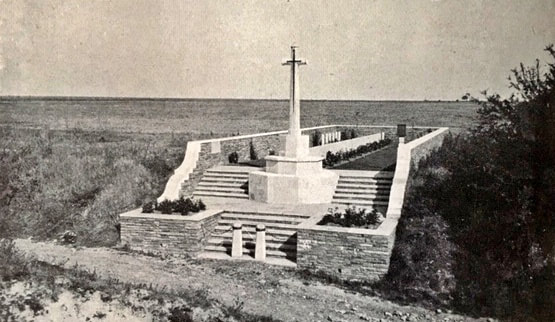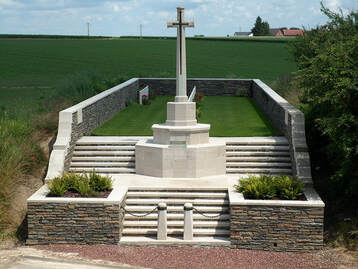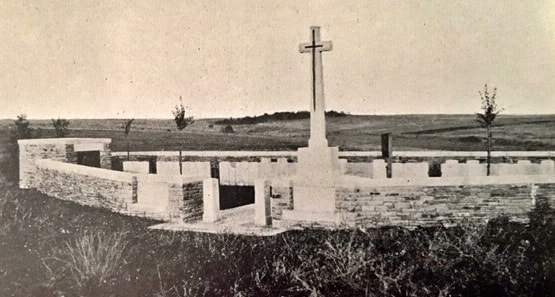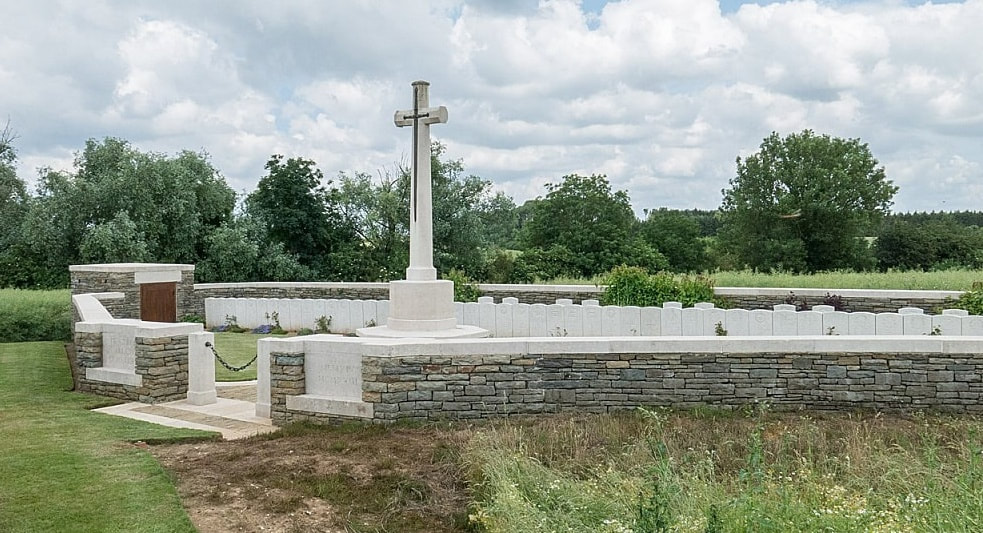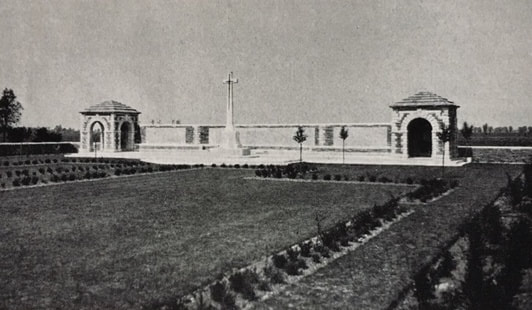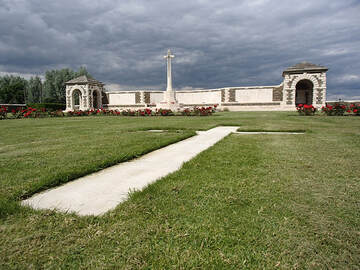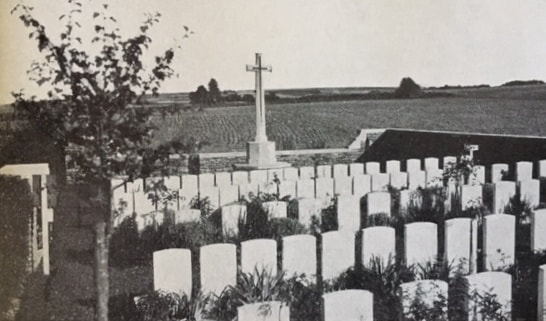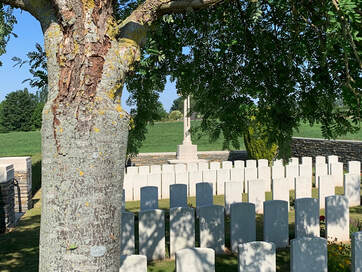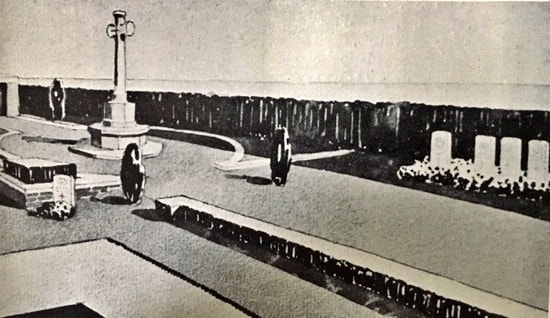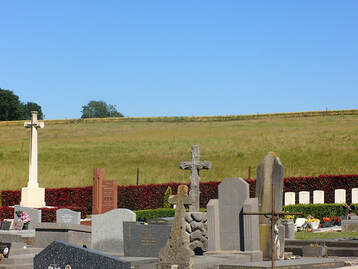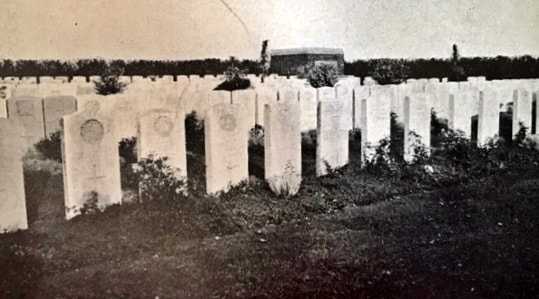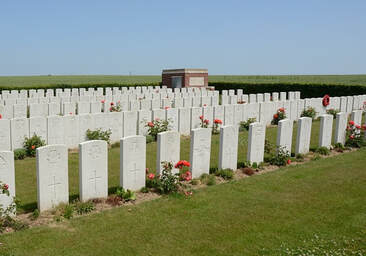"Silent Cities" Revisited
In 1929, Sidney C. Hurst published his book 'The Silent Cities', its intention was to show a general view of the finished cemetery and also to give basic instructions on how the cemetery could be visited. Mr Hurst travelled the battlefields taking images of all the completed or nearly completed cemeteries with 40 or more burials. Such was the task that he had set himself, he was allowed time off from working for the then Imperial War Graves Commission to finish his project. The book, shown above, was the finished article. Below, we have tried to recreate the images taken by Sidney Hurst in the modern day. We hope that you find the comparisons interesting. However, please note that it is not always possible to find the exact angle or position that an image was taken from all those years ago and modern cameras do not alway provide the same angle of image no matter how long is spent trying, this also makes identifying specific headstones a challenge. Please bear this in mind when viewing the modern images and the information below. Our intention is to give an approximate, modern day view of the original image and a short description of any major changes. We do not claim the images to be exact replicas.
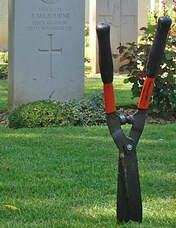
This page is currently under development
Click on new pictures to enlarge
Acheux British Cemetery
Very little has changed in these two images, it looks like there was originally the intention to have trees within this cemetery, at least two can be seen in the first image, these trees are no longer there. The graves look to be planted both front and rear in the original image, now they are planted to the front only. The tress to the rear of the cemetery and outside the boundary hedge now obscure the background but to the right of the second picture it can be seen that there is still open country. Note the man to the centre right of the image, he appears to be tending a grave, whether he is a gardener or a visitor we will never know.
Ancre British Cemetery
A slightly different angle on the new image here. The background remains the same although a copse has grown up behind the cross. Trees have now matured within the cemetery, the new picture is taken from underneath one of them, and the graves look to be planted both front and rear, today they are planted to the front only. Apart from this, very little has changed in the intervening years.
Auchonvillers Military Cemetery
This comparison is almost identical, the graves in the front row are that of Private A. Blackburn, Duke of Wellington's Regiment (right) and running left - 5 New Zealand burials. Spark, Dunbar, O'Connor, Orange and Steel. They make up part of Plot I. Row M. Apart from this the images differ very little.
Aveluy Communal Cemetery Extension
Very similar images of the Communal Cemetery Extension at Aveluy. The building in the original image, to the right of the cross is still in place but not shown on the new image due to a slightly different angle looking up the slope. The burials from left to right on the front row are those of, T. Coupe (Loyal North Lancs), M. Redmond (King's Liverpool), J. Slater (Loyal North Lancs) and C.H. Beard (Middlesex) these burials are part of Row B. Trees have now grown up along the western boundary of the cemetery and there are now a number of mature trees inside the north, east and southern boundaries of the cemetery.
Avesnes-le-Comte Communal Cemetery Extension
A more elevated angle for the modern image, shows that the trees planted in the original image have now matured and obscure the Cross of Sacrifice. The cemetery boundary is still a hedge but the trees which are on the left of the original image in the Communal Cemetery have been removed. At the far end of the cemetery are a number of houses, the original image shows no buildings whatsoever in that area.
Bazentin-le-Petit Communal Cemetery Extension
An almost exact image taken 90 years apart. Very little to say about this one, nothing much has changed, a tree planted in the top left hand corner has been removed and the trees behind the cross have more than doubled in size. The graves look to be planted front and rear as was common at that time but have now reverted to front only.
Bazentin-le-Petit Military Cemetery
Identical images of Bazentin-le-Petit Military Cemetery taken almost 90 years apart. The graves were again planted front and rear and are now front only. A good number of trees look to have been planted in the original image but only one now survives. This looks to be the one that can be seen on the left of the original image and is now shown as a thriving, mature tree on the new image.
Bécourt Military Cemetery
Very similar angles for this one, no changes to the structure, however the tree to the front left of the original image has gone. Apart from this small difference the cemetery is almost identical, even the trees to the rear of the images, outside the cemetery have a very similar shape as they slope down eastwards.
Beehive Cemetery
Beehive Cemetery, Willerval was named after a German Pill Box which stood 25 yards north of the cemetery. The original image shows four young trees, one in each corner, the modern image now shows these as tall, mature trees in the same positions. In the original image a simple wire fence has been erected as a boundary. Today's image shows a thick hedge surrounding the cemetery, meaning that the sole headstone on the right of the Hurst picture can no longer be seen.
Bois-Guillaume Communal Cemetery
These two images of Bois-Guillaume Communal Cemetery show little that is obviously different. There is still a private memorial cross on Plot 1. Row C of the original image, this would appear to be the grave of 19 year old, William James Jeffries of Worle, Weston Super-Mare, he served with the 12th Bn. Gloucestershire Regiment. The angles in these two images do differ slightly but little has changed over the decades.
Bois-Guillaume Communal Cemetery Extension
Little has changed in today's scene at Boisguillaume Communal Cemetery Extension. The shelter is still in place as is the house behind the shelter. To the left of the picture is another house, this one in the same place as the white house in the original image, it is very similar in design although the windows on the end aspect no longer match, it is probable that this property was redeveloped and extended over the intervening years. In the Extension itself, there is very little difference between the pictures, the only obvious ones are firstly, it appears that the original plot may have been surrounded by a wall, it is now a hedge and secondly, to the front of the original picture is what appears to be a flowerbed, this is now grassed over, other than these two changes, all is very much as it was when Sidney Hurst took his original picture.
Bouzincourt Communal Cemetery Extension
A very similar angle on both images here, although Sidney Hurst's image is taken from a more elevated position as can be seen from the proximity of the tree (now removed) to the bottom left of the image. To the rear of the cross there is now a shelter this had not been built at the time of Sidney Hurst's visit, nor does it appear on the original cemetery plan. Behind the cross are now houses and a farm which block the previously unimpeded background of the original. Once again, a number of trees planted within the cemetery have been removed.
Bouzincourt Ridge Cemetery
Very similar images taken 90 years apart of what is almost exactly the same scene. There is no noticeable change to either the cemetery or the background, with the usual exception of the removal of a number of trees from the cemetery in the intervening years.
Cantaing British Cemetery
An interesting comparison, firstly the headstones appear to have been completely turned around and now face the Cross rather than the shelter. All the trees within the cemetery, one of which is prominent in the original image have been removed and none now stand within the cemetery grounds. The landscape around the cemetery is now completely different, in the original image there was nothing whatsoever in the background giving a very open aspect to the cemetery, now on the new image you can see a modern housing estate has been built. The graves at the front of each image are from left to right, H. Webster (Worcesteshire Regt.), T. Beckwith, MM (Worcestershire Regt.), J. W. Fearn (Royal Field Artillery) and P. G. Smith (Royal Engineers) they make up Row E.
Carnoy Military Cemetery
A difficult angle to recreate and not quite right in the modern image, however, no real change to the cemetery in the almost 90 years in-between images. Trees in the entrance area now block out the view of the shelter but apart from that and the removal of a few trees in the main body of the cemetery, little has changed. The background to both images remains the same although the road to Suzanne, visible on the original image is now hidden by trees.
Courcelette British Cemetery
Similar but not exact replicas. A number of bushes and trees can be seen both to the left and right of the entrance shelter in the original image. Of these, 6 remain, one, either side of the cross and two on each side at right angles to the cross. To the left of the original image appears to be a sapling, no trees stand in the centre areas of the cemetery today. The landscape behind the cemetery remains unchanged in the decades since Sidney Hurst visited.
Dartmoor Cemetery
Two very similar images of Dartmoor Cemetery, Sidney Hurst had set his camera up on the plinth of the Cross of Sacrifice to take this slightly elevated image, the shadow of the top of the cross can bee seen in at the foot of the picture. A large tree now partially obstructs part of Plot 2. Row F. The first main row running to the left of the tree is Plot II. Row E., on the original image a private memorial can be seen leaning against a headstone on a grave in row D. This would appear to be that of Private A. Knowles of the Manchester Regiment, the plaque is no longer in place. There are buildings still in place behind the cemetery, it is difficult to tell if these are the same ones or have been rebuilt. A further mature tree can now be seen in-between rows A and C and in line with the short row B.
Dernancourt Communal Cemetery
Not quite the same angle as the original which shows the Communal cemetery as still overgrown with a high hedge bordering it. No sign of the now present French graves can be seen either. The planted border to the graves on the right is wider on the original but that and a lower hedge apart very little has changed.
Dernancourt Communal Cemetery Extension
Two almost identical images, the saplings shown on the original image have grown into mature trees and now border the cemetery extension on two sides. The cemetery still has a sloping bank leading up to it and the road towards Millencourt still winds away to the north west.
Devonshire Cemetery, Mametz
Very similar images of this well visited cemetery, the plants bordering the wall to the right have now been removed and although the original image shows the graves planted front and rear, they now are planted to the front only. The background to the cemetery remains the same with the exception of a number of trees now standing on the skyline.
Drummond Cemetery, Raillencourt
Two almost identical images of Drummond Cemetery both taken with the field filled with crops. Trees that were growing in the original picture have been removed. It is possible the original image may show traces of a light railway running behind the cemetery. There does also appear to be a track running left to right down the slope at the rear of the cemetery and the modern image also shows traces of this, however, there is no actual track to be found in this vicinity today. Behind the track on the horizon is now an industrial estate and the very busy E19 motorway.
Euston Road Cemetery, Colincamps
The original image and the modern image were taken from the seat on the rear boundary wall of the cemetery. The first row of graves visible are those in Plot I. Row H. Some of the graves have an unusual layout in which headstones are placed to the rear of a row in a gap. If you look closely at the original image, the cross stands between two trees in the centre of the image, these trees were part of a row which ran left to right across the width of the cemetery where the grassed walkway in front of the cross ended. This row of trees has now been removed completely, the only remaining trees are those which line the boundary of the cemetery and two that stand to the immediate left and right of the cross. To the rear of the cemetery the landscape remains unchanged.
Fifteen Ravine British Cemetery
There are a number of changes between the two images of Fifteen Ravine British Cemetery, whilst the entrance shelter remains the same, the bushes to the left and right of the walkway have now been move to the very edge of the concrete and no longer line up with the outer edge of the shelter. Of the four saplings visible on the original image, two each side of the shelter, only one remains and that is the furthest to the right in front of the row of graves to the right against the hedge. A wire fence has been placed either side of the entrance to the walkway and against the hedge which provided the cemetery with its original boundary. Little has changed in the background although a number of trees have grown up behind the and to the right of the cross.
Fins New British Cemetery
These two images of Fins New British Cemetery are very similar. The landscape in the background has changed little although there are now a number of wind farms on the horizon. The tree to the right of the original image has now matured and one now stands to the left of the shelter as well although the original picture does not show this one. There also looks to have been a number of trees removed from the cemetery in the passing years. Apart from these small changes, mostly the cemetery remains the same.
Five Points Cemetery
These two images of Five Points Cemetery are taken from in-between rows B and C looking south-east towards Rocquingy-Equancourt Road British Cemetery on the horizon to the right of each image. There appears to be a number of floral tributes on row B and a white plaque stands in front of Row B. 12., which is the grave of Private Albert Beer, Army Service Corps, attd. IV Corps, Heavy Artillery. The tree in the centre to the rear of row C has been removed but the two trees against the far boundary remain. The land to the rear of the images remains unchanged.
Forceville Communal Cemetery Extension
Forceville Communal Cemetery Extension was one of the first experimental CWGC cemeteries to be constructed and whilst the layout has changed very little, one obvious difference is the removal of the stone walkway that led from the Cross of Sacrifice to the Remembrance Stone. It is not known why the path was removed. That apart, the cemetery has remained virtually unchanged in almost 90 years.
Frankfurt Trench Cemetery
Similar views of Frankfurt Trench Cemetery. The first grave on the left in the original image is that of Private G. Garforth (Border Regiment), our modern image starts one grave further along to the right with the grave of Private W. McAllum (Highland Light Infantry).
Very little has changed in the two views of this cemetery except, perhaps that the trees have been removed. The background remains reassuringly unchanged.
Very little has changed in the two views of this cemetery except, perhaps that the trees have been removed. The background remains reassuringly unchanged.
Fricourt British Cemetery (Bray Road)
There are a number of changes in the two images of this cemetery, firstly, the small bank to the right of the image was very well planted but is now bare except for a newly planted tree and the boundary hedge. It also looks as though there was possibly a wall along that boundary too at one point. A number of trees have also been removed from the main body of the cemetery. To the rear of the original image are a large number of buildings, which look to be part of the same farm, this has now been completely removed and a new house stands on the spot. Further up the road are a number of buildings now hidden by trees. The two headstones to the bottom right are those of Major R. H. Grieg, DSO (Royal Engineers) and Gunner John Donovan (Royal Garrison Artillery) they make up Row B. 2 and 3 respectively. It is interesting to note that Row B. 4 and 5 no longer exist although once there were two graves there which held the remains of German soldiers, these were presumably removed to the Fricourt German Cemetery. The grave to the right of the image is that of Serjeant H. Pragnell, MM (Royal Engineers) Row A. 2.
Gordon Cemetery
Identical views of Gordon Cemetery taken 90 years apart. No trace of the light railway that once ran in front of the cemetery and is visible in the original image now remains and in the modern image the area where it stood is now covered by crops. There are still two trees within the cemetery although a number of others look to have been removed over the years. Another change is the removal of the stone bollards which stood in the entrance to the cemetery and the boundary wall, the cemetery is now surrounded by hedges with just a very low wall remaining. We also have in the original image what appears to be the silhouette of the photographer to the left of the original image. The landscape to the rear of the images remains unchanged.
Gordon Dump Cemetery
Similar images Gordon Dump taken from the bottom of the cemetery, close to the original (now removed) entrance. Little has changed with the exception of the usual removal of a number of trees, two do remain to the right of the image. The original entrance was reached via a track on which once ran a light railway but was later closed and a new entrance made.
Grandcourt Road Cemetery
Grandcourt Road Cemetery in 1929 is very much identical to the modern day. Both images are taken at ground level and standing in-between rows B and C looking towards the Cross of Sacrifice. On the original image, just visible are two trees, today there are two mature trees in the same position. The headstones are planted both front and rear on the original image, now only the front is planted. An original wooden grave marker also remains on Sidney Hurst's image in front of a grave in row D. The modern day image now also shows a line of trees lining a farm track which runs diagonal to the rear of the cemetery. Apart from these few minor changes the cemetery looks very much the same, even the landscape behind the cemetery is virtually unchanged.
Grove Town Cemetery
These tow images are taken looking towards the Cross of Sacrifice from Plot I. Row A. The graves in the original image are from left to right; Captain M. J. Savory (Duke of Wellington's), Second Lieutenant R. J. Earland (South Wales Borderers), Second Lieutenant D. Wilson (Argyll and Sutherland Highlanders), Second Lieutenant R. C. Tokeley (Essex Regiment) and Second Lieutenant C. L. Davies (Middlesex). It does look however that graves have been added to the row on the left, the original image shows a large gap after the grave of Captain Savory but in the modern version there are at least two further headstones on the row both are unknown although one is from The Rifle Brigade. Two mature trees now stand either side of the cross and a number of other trees line the boundaries to either side of the cemetery. There is now also a shelter between Plots II and IV, this had not been built at the time the original image was taken. The landscape behind the cemetery remains untouched.
Habarcq Communal Cemetery Extension
This image shows Plot I. Row A of the cemetery, the grave to the right of the French cross is that of Second Lieutenant Anthony Harvey Bowman and the elongated cross on his headstone can be made out on the original image. The cemetery boundary remains the same and is still surrounded by a hedge although the trees from the original image to the right of the headstones are now gone. In the background, trees have grown up along the edge of the neighbouring field.
Hédauville Communal Cemetery Extension
Little has changed over the decades as can be seen in the comparison between these two images. The cemetery is still surrounded by trees and behind them the landscape is mostly clear. The graves are now only planted to the front, in the original picture they were also planted to the rear of the headstone. The cemetery boundary is still a hedge. Although 90 years apart the images show a very similar scene.
Hersin Communal Cemetery Extension
Two similar but not exact angles of this cemetery. The two saplings planted either side of the cross are now mature trees. The communal cemetery is still in use to the left of the images but much of it is now obscured by the bushes and trees. The only discernible change is that the boundary of the Communal Cemetery appears to have moved closer to the CWGC plot in the intervening years. Interestingly, the row of graves nearest the camera in each image (Plot I. Row G.) was initially meant to have French graves on it in addition to the CWGC graves, however it appears that the French graves were left scattered in the cemetery instead.
Houchin British Cemetery
The Cross of Sacrifice can no longer be seen in the new image due to the growth of the two trees, these can be seen as saplings in the original image. Interestingly, in the original image, each headstone appears to have some sort of plaque or tribute laid against it, these, of course are long gone. It does appear from the original picture that a number of other trees were originally planted within the cemetery and these have also grown to a great height. Finally, the original image appears to show a wooden structure, centre left, this was perhaps a gardeners hut but it is of course, long gone. The landscape surrounding the cemetery is largely unchanged, however, to the left of the cemetery and out of the picture on each of the image there is now an industrial site.
Longueval Road Cemetery
The road to Longueval still heads past the cemetery on the left and the village itself can still be seen on the skyline, the landscape behind the cemetery remains very similar to how it looked 90 years ago with the exception of a number of wind farms. One change in the modern image is the small religious shrine on the junction of the Longueval Road and the track beside the cemetery, it is housed in a small red brick structure. The cemetery itself is very much unchanged, although the hedge around the boundary has been allowed to grow and is now higher than the boundary wall.
Lonsdale Cemetery
Very similar images of Lonsdale Cemetery, taken from the same place but at a slightly narrower angle. We are standing just to the left of Plot 3. Row M., and the headstone that can be seen on the end of this row is that of Corporal T. Walton (Yorkshire Regt.) The second grave in is that of an unknown soldier. The trees on the left have now matured and line the boundary to the cemetery. Nothing has changed very much here in the passing years, the bench on the left, a place, perhaps to reflect, has gone but the cemetery still gently slopes down the valley.
Louvencourt Military Cemetery
The most obvious change in the years that have passed is the removal of the stone path that ran easterly from the entrance towards the Remembrance stone and then turned at right angles towards the north and south boundaries of the cemetery. This is similar to Forceville where the stone path was also removed. A quick look at the area where the path was laid shows that the trees that can be seen as saplings in the original image but are now strong and mature have spread their roots in the area where the path would have been and this is potentially the reason for its removal as it would have made the structure uneven and unsafe. The row of trees to the left of the path has also been removed. This apart, very little has changed, to the left of the original image can be seen the experimental French headstones and these still remain to this day
Marcoing British Cemetery
We are stood in-between Plots I and II and the full row in front of the camera is Plot I. Row E. The row to the bottom left of the camera is Plot II. Row A. There are now more structures in the background of the new image, although the building to the left of the original image remains. The imposing entrance shelter has not changed and the tree to the left of the entrance as we look at it has now grown tall and strong. The landscape behind the entrance shelter, with the exception of a number of newer buildings remains agricultural.
Masnières British Cemetery
This is an interesting comparison taken from the field opposite the cemetery. We are at slightly different angles but the first thing that you notice is that the road appears to have been raised at some point over the years. Where there were originally 5 steps from road to cemetery there are now just 2. The name panel is also now almost at ground level where it was once much further from the road. The Cross of Sacrifice now sits on a plinth which is a third of the height of the original. The trees that can be seen as newly planted in the original image are now fully grown but that apart the cemetery is visually unchanged.
Méaulte Military Cemetery
The landscape behind the cemetery is still very much unchanged, the road to Etinehem still winds its way towards Etinehem. We are stood diagonal to the entrance and the row in front is "F". The trees have been removed and the flower bed which can be seen stood centre right of the original image is now grassed over. The graves are now also only planted to the front. Meaulte is unfortunate in that many of the headstones, when replaced were changed for the experimental sandstone headstones which now gives what is a pretty cemetery a rather unusual, jumbled look.
Millencourt Communal Cemetery Extension
Mill Switch British Cemetery
Morlancourt British Cemetery No. 1
Morlancourt British Cemetery No. 2
Munich Trench Cemetery
A very similar, almost identical scene at Munich Trench today as it was 90 years ago. Still surrounded by a hedge, if you look closely to the left of the cross on the original image, you can see the growing sapling, this is shown as it is today on the modern day image. The only other change is that in the original image, both the front and reverse of the headstones were planted. Today, the flowers are only in front of the headstones.
New Munich Trench British Cemetery
The landscape has barely changed in these two images taken 90 years apart. The path to the rear of the cemetery which goes from right to left across the original image remains to this day. In Sidney Hurst's image, to the rear of the cemetery and either side of the Cross of Sacrifice can be seen two small trees, these are no longer within the cemetery today. To the front of the modern day image can be seen repair work to the wall, the stonework below the repairs is identical to the original image if you look closely.
Norfolk Cemetery
Noyelles-sur-l'Escaut Communal Cemetery Extension
Ovillers Military Cemetery
Peake Wood Cemetery
Péronne Road Cemetery
Point 110 New Military Cemetery
Point 110 Old Military Cemetery
Porte-de-Paris Cemetery, Cambrai
Proville British Cemetery
Quarry Cemetery, Montauban
Similar angles of Quarry Cemetery, Montauban. There is now shelter behind the Cross of Sacrifice as we look at the images, this had not been erected at the time of the original image. The road still winds its way uphill towards Bazentin but in the modern picture is hidden by trees. Both Images are taken from the bank in the corner, outside the cemetery. In the original image, against the far wall can still be seen a number of wooden crosses, this would later be replaced by the conventional headstones. In the near corner of the original image is a small tree, this was later removed and no trace remains.
Quatre-Vents Military Cemetery
Redan Ridge Cemetery, No. 2
Redan Ridge Cemetery, No.2. A slightly more elevated picture was taken by Sidney Hurst, although we are in almost an identical position for the modern image. On the left of the image is a single headstone and then moving right the headstones become 'doubles'. To the back, right of the original image, can be seen a small tree, this has now been removed. To the front left of the original image can be seen a sapling, this is the tree in front of the camera in the modern image. Two other things worth noting from the original picture, firstly, the farmer with his horse drawn plough, centre right of the image and also to the right of the sapling, we can see the shadow of the photographer (presumably, Sidney Hurst).
Redan Ridge Cemetery, No. 3
A slightly different angle on the modern image which shows the plinth where the Cross of Sacrifice should stand, on this visit it had been damaged and removed for repairs. The original image shows that were trees either side of the cross, these have now been removed, other than this, there is little difference in the intervening years between images. The landscape behind the cemetery remains unchanged.
Regina Trench Cemetery
A slightly different angle but taken from close to the original and to the left of the central walkway. The shelters and cross remain in place and the trees to the rear of the cross are now mature. However, the other trees that can be seen in the original picture on both sides of the walkway and in a line towards the camera have recently been removed. The landscape behind the cemetery remains the same as in the original image. Note the figure standing to the right of the image.
Ribécourt British Cemetery
Ribécourt Railway Cemetery
Rocquigny-Equancourt Road British Cemetery
Rue-Du-Bacquerot (13th London) Graveyard
An interesting comparison, although not an exact angle. The shelter remains in place but now has an information plaque attached to the facing wall. The cemetery appears to have a double wall at the front in the original image, this has now gone and the area in-between the two original walls flattened and the road dressed with tarmac to bring it to the same level as the cemetery entrance. Other than this, the entrance remains the same. Noticeable by their absence are a number of trees. in the original image, at least eight trees can be seen in the picture, of these, all but the two either side of the Cross of Sacrifice have been removed.
Rumilly-en-Cambrésis Communal Cemetery Extension
St. Olle British Cemetery
St. Sever Cemetery
Not an identical match by any means but still in place down the central driveway is the French memorial and wall. Interestingly, the graves appear to be closer to the path in the original image. Judging by the position of the trees in that image, it appears that the grassed area was extended onto the driveway and bushes planted as a border.
St. Sever Cemetery Extension
Once again, not quite the same angle, but both images are taken from the Cross of Sacrifice which can just be seen in the bottom left of the original image. To the right is the chapel and the central walkway remains, new trees have been planted to replace the originals.Behind the chapel in the new picture is the skyline of the suburbs of Rouen.
Serre Road Cemetery No. 3
Stump Road Cemetery
Stump Road Cemetery has changed very little, if at all. The storage facility is still in place and there is still nothing in the background or on the horizon except for a small copse of trees (centre). The images are taken from the front row (A), the first headstone that can be seen is that of Frederick Barnes, 7th Bn. Queen's Own (Royal West Kent Regiment) and John Douglas Scott, 8th Bn. Border Regiment shares the headstone but his regimental badge cannot be seen. This headstone is Row A. 7/8. The first full headstone that we can see is that of M. Curran, 8th Bn. Border Regiment and Horace Frederick Chatterton, 7th Bn. The Buffs (East Kent Regiment), this grave is recorded as A. 9/10. To the rear of the row A and in front of row B are two wooden crosses. To the right of the shelter on row A there also appears to be a gap where a wooden cross still stands.
Sucrerie Military Cemetery, Colincamps
Sucrerie Cemetery, Épinoy
Sunken Road Cemetery, Villers-Plouich
Ten Tree Alley Cemetery
The original image of Ten Tree Alley still shows gaps in the long, joined row of headstones that form Row A., of the cemetery, these gaps appear to still have the original wooden crosses marking the grave. In the modern picture, taken by Werner Van Caneghem, the Row A., now consists of 1 completely joined line of 54 burials. From the left, the first headstone missing would appear to be that of Private E. Briggs, 2nd Bn. King's Own Yorkshire Light Infantry and the next gap that of Private Irving Sykes of the same battalion and regiment. Thereafter it becomes too difficult to distinguish the individual headstones on the original image. Sidney Hurst's picture shows at least three young trees growing within the boundaries of the cemetery, today, there are none. The landscape in the background, apart from the growth of trees and bushes, remains unchanged.
V.C. Corner Australian Cemetery And Memorial
One major change in the intervening years between photographs, is the inclusion of two stone crosses laid into the grass in front of the memorial, these are not seen in the original picture. The rose beds remain, although in a slightly different design whilst a number of trees planted in front of the memorial in the original image have been removed.
Ville-sur-Ancre Communal Cemetery Extension
Two images of Ville-sur-Ancre Communal Cemetery Extension, although these images were taken 90 years apart nothing has really changed. The small tree to the left of the original image has now grown into a thick trunked mature tree. The graves in the original image appear to have been planted both front and rear but are now only planted to the front. Behind the cross, which is now partially obscured due to the tree, the landscape has barely changed.
Villers-Plouich Communal Cemetery
Waggon Road Cemetery
There is very little to comment on in these two similar images of Waggon Road Cemetery. The two headstones visible in the first gap on the front row left of the original image are those of Private H. Embrey, 20th Bn. Manchester Regiment and Private William Alfred Randall, 9th Bn. Devonshire Regiment. in Row E 7/8 respectively, the row at the front of each image is Row F. In the original image there looks to be at least two trees growing, in the modern image, taken by Johan Pauwels, there are none. The cemetery is still surrounded by a hedge and the landscape behind, remains untouched.

